 December 6, 2018 John E. Ross, KD8IDJ, Editor
| |||||||
Fox-1Cliff Launched Successfully, Now Designated AO-95 Satellite enthusiasts soon will have another "bird" to use. AMSAT's Fox-1Cliff CubeSat was successfully launched and placed into orbit this week. A SpaceX Falcon 9 vehicle carried Fox-1Cliff and several other satellites -- including other Amateur Radio payloads -- into space on December 3 at approximately 1334 UTC from Vandenberg Air Force Base in California, following a 1-day launch delay. AMSAT said early on December 4 (UTC), several stations in Brazil reported hearing the voice beacon "Fox-1Cliff Safe Mode," confirming that the satellite was alive. Fox-1Cliff has been officially designated as AO-95.
The Fox-1Cliff downlink for FM voice and data-under-voice (DUV) is 145.920 MHz. Uplinks are 435.300 and 1267.300 MHz. In addition to Fox-1Cliff, the SpaceX SSO-A: SmallSat Express mission carried FUNcube on ESEO, JY1-SAT, K2SAT, and ExseedSat. The reusable Falcon 9 vehicle launched 64 payloads in all. Fox-1Cliff carries the Fox-1 U/v FM repeater, AMSAT's L-Band Downshifter, the flight spare of the AO-85 Vanderbilt University Low Energy Proton (LEP) radiation experiment, and the standard Fox-1 Penn State University-Erie MEMS gyroscope experiment. Virginia Tech provided a video graphics array camera that's similar to the one on AO-92, but which will provide images at a higher 640 × 480 resolution. Fox-1Cliff is named in honor of longtime AMSAT member, contributor, and benefactor Cliff Buttschardt, K7RR (SK), who died in 2006. His contributions to AMSAT and other Amateur Satellite programs -- including his service as an adviser during the initial development of the CubeSat specification at California Polytechnic State University -- earned him the Lifetime Achievement Award from Project OSCAR in 2006.
"If you are capturing telemetry with FoxTelem, please be sure that 'Upload to Server' is checked in your settings and your Ground Station Params are filled in as well," AMSAT said in advance of the launch. The on-orbit checkout procedure will be similar to Fox-1D and could be completed in as few as 7 days. "It is very important, not to mention just plain good amateur operating practice, to refrain from using the transponder uplink, so we can do the on orbit tests, including when we turn on transponder mode for testing," AMSAT said. -- Thanks to SpaceX and AMSAT Vice President-Engineering Jerry Buxton, N0JY 2018 QST Antenna Design Competition Winners Announced ARRL has announced the winners of the 2018 QST Antenna Design Competition. "Dozens of entries were received, but only three could win," said QST Editor Steve Ford, WB8IMY.
Requirements for the 2018 QST Antenna Design Competition included an antenna for one or more bands between 2200 meters and 10 meters that could fit within a 30 × 50 foot area and be no taller than 30 feet above ground at any point. "In other words, we were seeking designs for LF, MF, or HF antennas for limited-space applications," Ford explained. "We wanted to see innovative antennas that would allow amateurs to get on the air without the need for towering supports and acres of property. Our winners not only met this challenge, they exceeded it." The winners:
Details of all three winning designs will appear in a future issue of QST. Several entries earned Honorable Mention, and those designs will be published in QST later in 2019. Honorable Mention recipients were:
Ford expressed his appreciation to all participants and to Joel Hallas, W1ZR, who headed up the judging process. "It took weeks to evaluate the entries, with a lot of that time spent running antenna-modeling applications and studying the results," Ford said. Next: The 2019 QST Key Design Competition Hams have been building their own Morse keys since the dawn of Amateur Radio, and some creations have become legend. In 2019, QST is inviting participants to submit their best Morse key/paddle designs in the QST Key Competition. Design styles can include straight key, semiautomatic key (bug), paddle, or sideswiper. The winner in each category will receive $250. Only one entry may be accepted per person or team, and the deadline to submit is June 1, 2019.
Entries must include the actual key (it will be returned following judging), as well as detailed drawings, photos, and a written narrative. Winners will be chosen based on ingenuity of design, ergonomics of operation, and overall craftsmanship. The judges' decisions are final. The key must be an independent mechanical device, not an integral part of another device, such as an electronic keyer. Keys must be the sole creations of the entrants and not available for sale. Complete details and entry requirements will appear in the January 2019 edition of QST. The digital edition will go live on Friday, December 7, 2018. The Doctor Will See You Now! "RF Safety" is the topic of the new (December 6) episode of the "ARRL The Doctor is In" podcast. Listen...and learn!
Every 2 weeks, your host, QST Editor-in-Chief Steve Ford, WB8IMY, and the Doctor himself, Joel Hallas, W1ZR, will discuss a broad range of technical topics. You can also email your questions to doctor@arrl.org, and the Doctor may answer them in a future podcast. Enjoy "ARRL The Doctor is In" on Apple iTunes, or by using your iPhone or iPad podcast app (just search for "ARRL The Doctor is In"). You can also listen online at Blubrry, or at Stitcher (free registration required, or browse the site as a guest) and through the free Stitcher app for iOS, Kindle, or Android devices. If you've never listened to a podcast before, download our beginner's guide. ARRL CEO Howard Michel, WB2ITX, to Keynote 20th Annual Ham Radio University ARRL's new CEO, Howard Michel, WB2ITX, will keynote the annual Ham Radio University (HRU), which will mark its 20th anniversary on Saturday, January 5, 2019, 7:30 AM until 3:30 PM. The event, which HRU will include nearly 30 informational forums moderated by local experts in a broad range of Amateur Radio activities. Topics include Assembling an Amateur Radio Station; Communicating through Amateur Radio Earth Satellites; Remote Station Operating over the Internet, and Emergency Communications, plus three hands-on workshops on Cable Theory and RF Connectors; Ethernet Connectors, and Test Equipment. Presented in cooperation with LIU/Post public radio station WCWP (88.1 FM), HRU 2019 anticipates some 300 attendees. Amateur Radio examinations will be offered. Parking is free, and a cafeteria will be open for breakfast and lunch. The suggested donation for attendees is $5. JOTA Reports 36% Growth in Scout Participation for 2018 Scouting's Jamboree on the Air (JOTA) 2018 reports that total Scout participation in the annual fall event jumped by 36% from 2017. Each year, more than 1 million Scouts and Guides get together over the airwaves for JOTA, which takes place on the third weekend of October. Since the first JOTA in 1958, millions of Scouts have become acquainted via Amateur Radio, and contacts sometimes result in relationships that extend for many years.
JOTA Coordinator Jim Wilson, K5ND, said he was pleased with this year's numbers and hopes that 2019's event will show a continued increase, despite a lack of sunspots. "Looking over the numbers, a big part of the increase in JOTA Scout participation came from the World JOTA-JOTI (Jamboree on the Internet) Team's registration and reporting system," Wilson told ARRL. "We had 233 stations report results on the US system, which is comparable to last year's 226. In addition to that, 90 stations reported their results on the World system. After eliminating duplicates, this added 33 to our total of 266 station reports. That, chiefly, accounts for the increase in total Scout participation. In summary, perhaps this nice increase is due primarily to more accurate reporting."
Wilson said he's also looking forward to the final tally on US participation in JOTI. "Location registration in the US jumped from 274 last year to 610 this year," he said. "Several Amateur Radio operations reported using JOTI chat and Skype to greatly improve their ability to generate Scout-to-Scout conversations between the US and the rest of the world. Of course, VoIP modes like D-STAR, DMR, and EchoLink also helped in our solar minimum." World JOTA-JOTI numbers are not expected until early 2019, as each country reports its results by mid-December followed by number crunching and compiling of the report, Wilson explained. "Thanks to everyone who set up a JOTA station and helped Scouts experience the technology, fun, and magic of Amateur Radio. Let's do it again next year," he concluded. North American Collegiate Championship Adds NAQP RTTY for 2019 In something new for 2019, the Society of Midwest Contesters (SMC) has announced an expansion of the North American Collegiate Championship (NACC), which takes place in conjunction with the North American QSO Party (NAQP). The inaugural event this past January only covered the NAQP SSB event. In 2019, the NACC will also cover the NAQP RTTY event. NCJ (National Contest Journal) sponsors the NAQP. The NAQP SSB runs from 1800 UTC on January 19 to 0600 UTC on January 20, 2019. The NAQP RTTY runs 1800 UTC on February 23 to 0600 UTC on February 24. The NACC format is generally the same as those for the NAQP, but there are some differences.
"This is an opportunity for your college club station to compete with any college and university in North America," the SMC said in announcing the 2019 running of the NACC. "You can take on your state or conference rivals. With planning and practice, it is possible to win a national championship." NACC stations can follow the action on a real-time online scoreboard. Participants must register college/university and call sign. Once registered, stations will receive instructions on how to set up, which includes inserting and activating a link in the participating stations contest logging software. Collegiate stations will use their college club call signs, and the station must be located on the school's physical campus. The NAQPs impose a 100 W power limit. All operators must be enrolled students and club members. As of November 14, 15 collegiate station were registered. The exchange for the NAQPs is your name and state/Canadian province/NA country, and participants may use any name associated with the school, which must remain the same for the entire event. The College Contest Class will be multioperator, single radio, M/1. Stations may use assistance similar to the M2 class and will submit logs in the M2 class via the NAQP log submission page. NCJ will publish college stations in their own class. Awards will be based on the adjudicated logs and not the online finish. Participants may operate the entire 12 hours of the contest. Awards will be given out for National Champion, Runner-up, and State Champions. Awards will be sponsored by SMC, NCJ, and Icom. For more information, contact Craig Thompson, K9CT. FCC Tells LED Sign Marketers to Abide by Statutes and Rules The FCC Enforcement Bureau has called on marketers of light-emitting diode (LED) signs to ensure that these lights comply with FCC rules. Since March of this year, the agency has entered into 21 settlement agreements with companies that marketed noncompliant LED signs in violation of the Communications Act and FCC rules. The settlements yielded approximately $850,000 in penalties, and commitments to ensure compliance with the law going forward. "In light of these recent settlements, we remind LED sign marketers of their obligations under the law," said Enforcement Bureau Chief Rosemary Harold. "The FCC takes seriously its responsibility in ensuring that energy-emitting devices like LED lights do not interfere with authorized transmissions." LED lights are often used in digital billboards and other commercial and industrial applications, including billboards and large video displays in sports arenas. Given the electrical design of these lights, they may emit RF energy. Prior to being marketed in the US, LED sign models must be tested and comply with FCC technical standards and must include the proper labeling, identification, and user information disclosures. The FCC Office of Engineering and Technology (OET) oversees the equipment authorization process for RF devices, including LED signs. The Enforcement Bureau investigated hundreds of indoor and outdoor LED sign models and discovered repeated FCC rule violations concerning the failure to market the models with the required equipment authorizations, labeling, and user information disclosures. Read more. New Two-Ham ISS Crew Launched to ISS is the First Since Aborted October Flight Three astronauts -- including two radio amateurs -- have docked at the International Space Station (ISS) on the first crewed Soyuz vehicle launch since a dramatic failure in October. The astronauts, from the US, Canada, and Russia, left Kazakhstan at 1130 UTC on December 3, and the Russian space agency Roscomos confirmed their successful docking at the station. On board were David Saint-Jacques, KG5FYI, a Canadian engineer, astrophysicist, and medical doctor; space veteran Oleg Kononenko, RN3DX, of Russia, and Anne McClain, of the US. Investigators have blamed a faulty sensor, said to have been damaged during assembly in Kazakhstan. Crew commander Kononenko said his crew recognized the risks of spaceflight as part of their profession and expressed confidence in the flight preparation.
The three-person crew's mission was originally set for later this month, but officials moved up the date to avoid leaving the space station unstaffed, when the current ISS crew of cosmonaut Sergey Prokopyev and astronauts Serena Auñón-Chancellor, KG5TMT, and Alexander Gerst, KF5ONO, return to Earth on December 20. Meanwhile, NASA astronaut Nick Hague, KG5TMV, who was on the aborted October 11 Soyuz launch, is getting ready for another try. Hague, NASA astronaut Christina Hammock Koch, and cosmonaut Alexey Ovchinin are scheduled to launch from Baikonur Cosmodrome on February 28 aboard the Russian Soyuz MS-12 spacecraft. The trio will join the ISS Expedition 58 crew that just went up, and they will return to Earth in October 2019 as members of Expedition 60. Hague and Koch will serve as flight engineers for Expeditions 59 and 60. Ovchinin will serve as a flight engineer on Expedition 59 and as the commander of Expedition 60. This will be Koch's first spaceflight. Hague and Ovchinin were on their way to join the station's Expedition 57 crew on October 11, when their Soyuz's rocket booster experienced a malfunction shortly after launch, aborting the mission. Both returned safely to Earth. The MS-10 flight abort marked the first Russian human spaceflight booster accident in 35 years. Investigators looking into the October 11 incident said afterward that other Soyuz vehicles may have been similarly defective, but pointed out that additional pre-flight checks had been introduced. NASA offered its own reassurances about continued cooperation with and confidence in the Russian space program. 2018 ARRL Hiram Percy Maxim Memorial Award Presented in Festive Style The winner of the 2018 ARRL Hiram Percy Maxim Memorial Award, Ruth Willet, KM4LAO, received the award plaque and allotted $1,500 on November 3 in a festive award ceremony during the Stone Mountain Hamfest in Lawrenceville, Georgia. Hosted by Alford Memorial Radio Club, the Stone Mountain Hamfest was also the 2018 ARRL Georgia Section Convention. ARRL Southeastern Division Director Greg Sarratt, W4OZK, congratulated Willet and presented the award before an enthusiastic crowd.
"The Hiram Percy Maxim Memorial Award is one of the top awards that ARRL awards annually," Sarratt said. "When I saw Ruth's nomination package come in, it was a no-brainer for me to support Ruth to win the award this year. I am very proud of this award and honored to be here to present it to Ruth." Georgia Section leadership team members were in attendance, including Section Manager David Benoist, AG4ZR. Willet, an Amateur Extra-class licensee, is a junior at Kettering University, where she is dual-majoring in engineering physics and mechanical engineering. She is an active member of ARRL, the Gwinnett Amateur Radio Society, the North Fulton Amateur Radio League, and the Amateur Radio Club of Columbia County in Georgia, the Genesee Country Amateur Radio Club in Michigan, the Young Ladies Radio League, the Straight Key Century Club, CWOps, and AMSAT. She is also president of the Kettering University Amateur Radio Club (K8HPS). "This award means so much because of the people that have made my Amateur Radio adventures so meaningful, many of whom nominated me for this honor," Willet said. "I hope that this award will give me a platform to continue encouraging more people to get licensed and involved in this amazing hobby." Her mother, Sharon Willet, KM4TVU, baked and decorated cakes for the award reception. The Hiram Percy Maxim Memorial Award is given annually by the ARRL Board of Directors to a radio amateur under the age of 21 whose accomplishments and contributions to both Amateur Radio and the local community are of an exemplary nature. In Brief...
The K7RA Solar Update Tad Cook, K7RA, Seattle, reports: After 9 days with no sunspots, Sunspot Group 2729 emerged on December 5. The sunspot number on that date was 16. The average daily solar flux was 68.9, unchanged from last week. The average daily planetary A index rose from 3.3 to 7, while the average mid-latitude A index jumped from 2.1 to 4.9.
The predicted planetary A index is 8 on December 6 - 9; 5 on December 10 - 16; 8 on December 17 - 18; 5 on December 19 - 27; 8 on December 28; 12 on December 29 - 30; 10 on December 31; 12 on January 1; 8 on January 2 - 5; 5 on January 6 - 12; 8 on January 13 - 14, and 5 on January 15 - 19. This weekend is the ARRL 10 Meter Contest. While solar activity is so low that it doesn't really support 10-meter propagation very well, there is always the winter sporadic-E activity. Sunspot numbers for November 29 - December 5 were 0, 0, 0, 0, 0, 0, and 16, with a mean of 2.3. The 10.7-centimeter flux was 67.8, 67.9, 69.4, 69, 68.4, 68.7, and 70.9, with a mean of 68.9. Estimated planetary A indices were 3, 3, 8, 12, 10, 8, and 5, with a mean of 7. Estimated mid-latitude A indices were 2, 2, 4, 9, 9, 5, and 3, with a mean of 4.9. Just Ahead in Radiosport
See the ARRL Contest Calendar for more information. For in-depth reporting on Amateur Radio contesting, subscribe to The ARRL Contest Update via your ARRL member profile email preferences. Upcoming ARRL Section, State, and Division Conventions
Find conventions and hamfests in your area.
. .
Subscribe to...
Free of charge to ARRL members...
| |||||||
.JPG) "Just before 0040 UTC, AMSAT Fox-1 Team Member Burns Fisher, WB1FJ, was the first to submit and upload telemetry to the AMSAT servers," AMSAT
"Just before 0040 UTC, AMSAT Fox-1 Team Member Burns Fisher, WB1FJ, was the first to submit and upload telemetry to the AMSAT servers," AMSAT 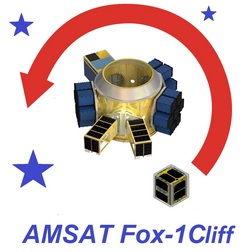 AMSAT is asking Amateur Radio satellite enthusiasts to listen for Fox-1Cliff's telemetry for the initial 72 - 96 hours as on-orbit checkout gets under way.
AMSAT is asking Amateur Radio satellite enthusiasts to listen for Fox-1Cliff's telemetry for the initial 72 - 96 hours as on-orbit checkout gets under way.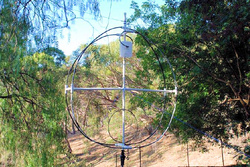
.jpg)
 Sponsored by
Sponsored by 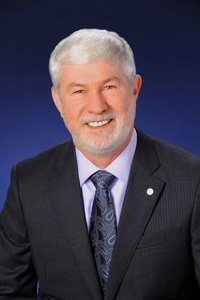 also serves as the ARRL New York City/Long Island Section Convention, takes place in the Hillwood Commons Student Center on the campus of Long Island University/Post campus in Brookville, New York. Michel will speak at noon.
also serves as the ARRL New York City/Long Island Section Convention, takes place in the Hillwood Commons Student Center on the campus of Long Island University/Post campus in Brookville, New York. Michel will speak at noon..png) This year, 10,703 Scouts took part in the event, compared with 7,872 last year. Participating Amateur Radio operators topped 1,000 for the first time since 2016. At 610, the number of registered JOTA locations was way up, as was the number of JOTA stations registered, with 314. Participating JOTA stations reported contacts with stations in 99 countries, also up over 2017.
This year, 10,703 Scouts took part in the event, compared with 7,872 last year. Participating Amateur Radio operators topped 1,000 for the first time since 2016. At 610, the number of registered JOTA locations was way up, as was the number of JOTA stations registered, with 314. Participating JOTA stations reported contacts with stations in 99 countries, also up over 2017.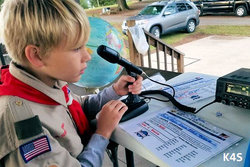
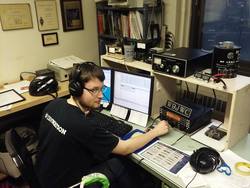
.jpg) Adherence to the FCC's equipment authorization and marketing rules is critical because radio frequency emissions from the signs may cause harmful interference to licensed communications, such as wireless services, the FCC said.
Adherence to the FCC's equipment authorization and marketing rules is critical because radio frequency emissions from the signs may cause harmful interference to licensed communications, such as wireless services, the FCC said..jpg)
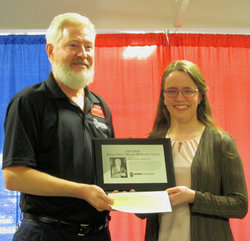
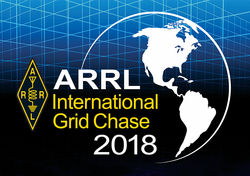 The 2018 ARRL International Grid Chase (IGC)
The 2018 ARRL International Grid Chase (IGC) .jpeg) The familiar call sign of Paul Bittner, W0AIH (SK), is back on the air. The FCC granted the Fall Creek Contest Club's (FCCC) application for the W0AIH call sign on December 1, and it was in use during the ARRL 160-Meter Contest over the December 1 - 2 weekend. Top Band was Bittner's favorite. Contesters can expect to hear W0AIH on the air in future operating events. Scott Neader, KA9FOX, is spearheading a
The familiar call sign of Paul Bittner, W0AIH (SK), is back on the air. The FCC granted the Fall Creek Contest Club's (FCCC) application for the W0AIH call sign on December 1, and it was in use during the ARRL 160-Meter Contest over the December 1 - 2 weekend. Top Band was Bittner's favorite. Contesters can expect to hear W0AIH on the air in future operating events. Scott Neader, KA9FOX, is spearheading a  The Canadian National Parks on the Air event (
The Canadian National Parks on the Air event (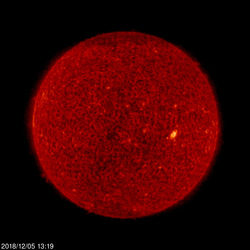 Predicted solar flux for the next 45 days is 71 on December 6-8; 70 on December 9, and 68 on December 10 - January 19.
Predicted solar flux for the next 45 days is 71 on December 6-8; 70 on December 9, and 68 on December 10 - January 19.







